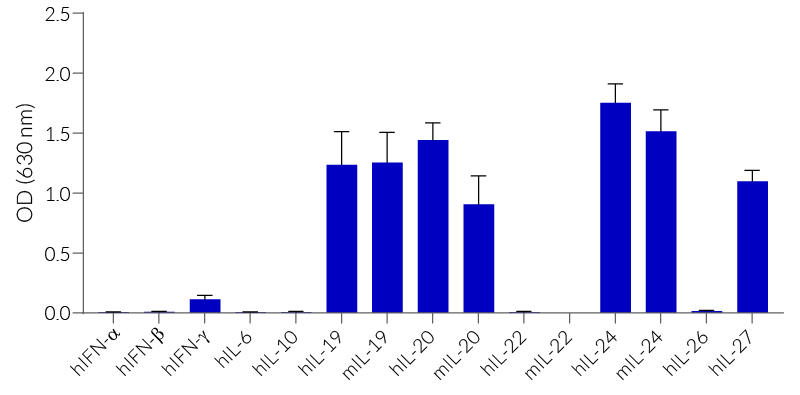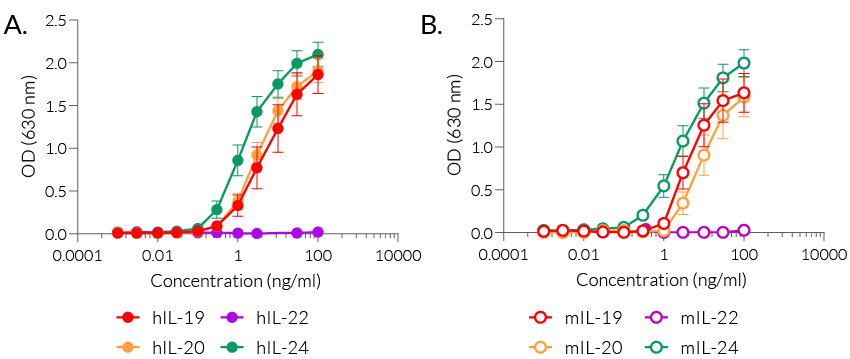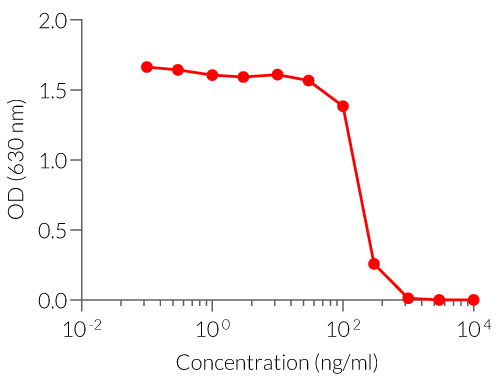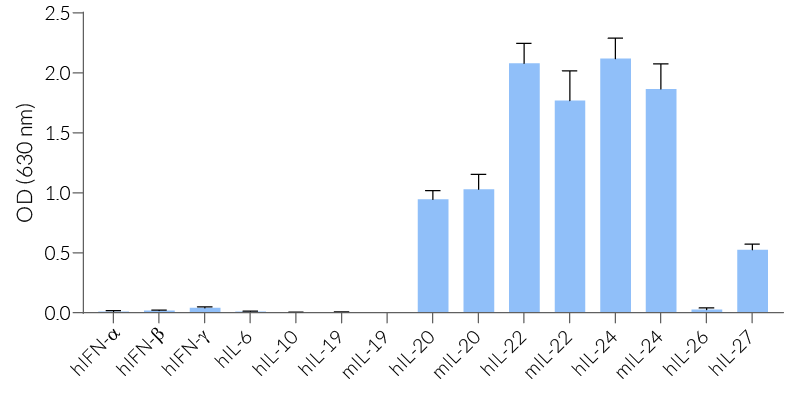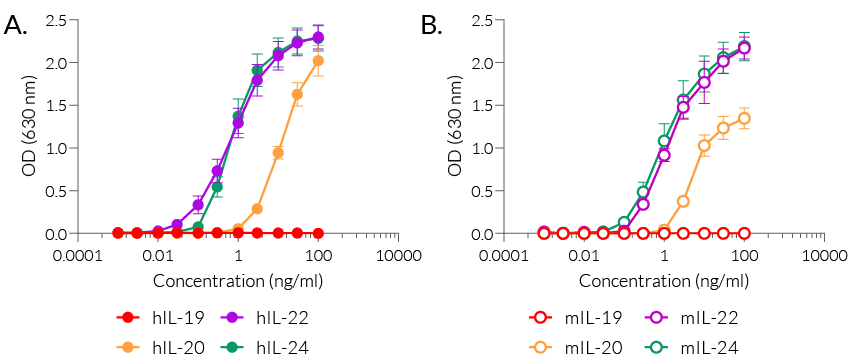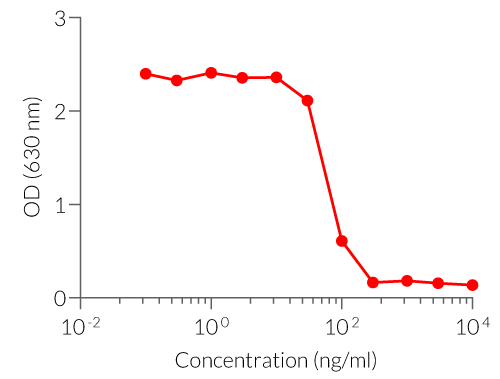IL-19, IL-20, IL-22 & IL-24 Reporter HEK 293 Cells
| Product | Unit size | Cat. code | Docs. | Qty. | Price | |
|---|---|---|---|---|---|---|
|
HEK-Blue™ IL-19/IL-20 Cells Human and murine IL-19, IL-20 & IL-24 cytokine HEK293 reporter cells |
Show product |
3-7 x 10e6 cells |
hkb-il1920
|
|
||
|
HEK-Blue™ IL-19/IL-20 vial Additional cell vial |
Show product |
3-7 x 10e6 cells |
hkb-il1920-av
|
|||
|
HEK-Blue™ IL-20 Cells Human and murine IL-20, IL-22 & IL-24 cytokine HEK293 reporter cells |
Show product |
3-7 x 10e6 cells |
hkb-il20
|
|
||
|
HEK-Blue™ IL-20 vial Additional cell vial |
Show product |
3-7 x 10e6 cells |
hkb-il20-av
|
Notification: References #hkb-il1920-av and #hkb-il20-av can only be ordered together with references #hkb-il1920 and #hkb-il20, respectively.

IL-19, IL-20, IL-22, and IL-24 sensing
in HEK-Blue™-derived cells
IL-19, IL-20 and IL-24 Reporter Cells
HEK-Blue™ IL-19/IL-20 and HEK-Blue™ IL-20 reporter cells were engineered from the human embryonic kidney HEK 293 cell line to detect bioactive interleukin 19 (IL-19), IL-20, IL-22, and IL-24 by monitoring the activation of the JAK/STAT3 pathway:
— HEK-Blue™ IL-19/IL-20 cells expressing the IL-20 type I receptor for the detection of human and murine IL-19, IL-20, and IL-24
— HEK-Blue™ IL-20 cells expressing the IL-20 type II receptor for the detection of human and murine IL-20, IL-22, and IL-24
IL-19, IL-20, IL-22, and IL-24 are closely related cytokines that belong to the IL-20 subfamily and play an important role in the protection of barrier tissues. They share the heterodimeric IL-20 type I and type II receptors composed of the IL-20Rα and IL-20Rβ chains, and IL-22Rα1 and IL-20Rβ chains, respectively [1, 2].
Cell Line description:
HEK-Blue™ IL-19/IL-20 and HEK-Blue™ IL-20 cells were generated by stable transfection with the genes encoding for the human IL-20 type I receptor IL-20Rα and IL-20Rβ chains, or type II receptor IL-20Rβ and IL-22Rα chains, respectively. Both cell lines also feature a stable expression of human STAT3 to obtain a fully functional IL-19, IL-20, or IL-24 signaling pathway as well as a STAT3-inducible secreted embryonic alkaline phosphatase (SEAP) reporter. The binding of IL-19, IL-20, IL-22, or IL-24 to their receptor triggers a signaling cascade leading to the activation of STAT3 and the subsequent production of SEAP. This can be readily assessed in the supernatant using QUANTI-Blue™ Solution, a SEAP detection reagent.
— HEK-Blue™ IL-19/IL-20 cells, expressing the IL-20Rα and IL-20Rβ chains (type I receptor), respond to IL-19, IL-20, or IL-24 stimulation. They also respond to IL-27 and IFN-γ. They do not respond to IL-6, IL-10, IL-22, IL-26, and IFN-α/β (see figures).
— HEK-Blue™ IL-20 cells, expressing the IL-22Rα and IL-20Rβ chains (type II receptor), respond to IL-20, IL-22, or IL-24 stimulation. They also respond to IL-27 and IFN-γ. They do not respond to IL-6, IL-10, IL-19, IL-26, and IFN-α/β (see figures).
Key features:
- Fully functional IL-19, IL-20, IL-22, and IL-24 signaling pathways
- Readily assessable STAT3-inducible SEAP reporter activity
Applications:
- Detection of human and murine IL-19, IL-20, and IL-24 using HEK-Blue™ IL-19/IL-20 cells
- Detection of human and murine IL-20, IL-22, and hIL-24 using HEK-Blue™ IL-20 cells
- Screening of anti-IL-19, anti-IL-20, anti-IL-22, and anti-IL-24 antibodies
References:
1. Ouyang W. et al., 2019. IL-10 family cytokines IL-10 and IL-22: from basic science to clinical translation. Immunity. 50:871-891.
2. Wei H. et al., 2019. Interleukin-10 family cytokines: Immunobiology and structure. Adv Exp Med Biol. 1172:79-96.
Specifications
HEK-Blue™ IL-19/IL-20 cells
Antibiotic resistance: Blasticidin, Puromycin, Zeocin®
Growth medium: DMEM, 4.5 g/l glucose, 2 mM L-glutamine, 10% (v/v) fetal bovine serum, 100 U/ml penicillin, 100 μg/ml streptomycin, 100 μg/ml Normocin™
Guaranteed mycoplasma-free
Specificity: Human & murine IL-19, IL-20, and IL-24
Detection ranges:
- 3 - 100 ng/ml for human & murine IL-19
- 1 - 100 ng/ml for human & murine IL-20
- 1 - 100 ng/ml for human & murine IL-24
HEK-Blue™ IL-20 cells
Antibiotic resistance: Blasticidin, Puromycin, Zeocin®
Growth medium: DMEM, 4.5 g/l glucose, 2 mM L-glutamine, 10% (v/v) fetal bovine serum, 100 U/ml penicillin, 100 μg/ml streptomycin, 100 μg/ml Normocin™
Guaranteed mycoplasma-free
Specificity: human & murine IL-24; human IL-20
Detection ranges:
- 3 - 100 ng/ml for human & murine IL-20
- 1 - 100 ng/ml for human & murine IL-24
Contents
Note: Each cell line is sold separately.
HEK-Blue™ IL-19/IL-20 cells
- 1 vial containing 3-7 x 106 cells
- 1 ml Blasticidin (10 mg/ml)
- 1 ml Puromycin (10 mg/ml)
- 1 ml Zeocin® (100 mg/ml)
- 1 ml Normocin™ (50 mg/ml)
- 1 ml of QB reagent and 1 ml of QB buffer (sufficient to prepare 100 ml of QUANTI-Blue™ Solution, a SEAP detection reagent).
HEK-Blue™ IL-20 cells
- 1 vial containing 3-7 x 106 cells
- 1 ml Blasticidin (10 mg/ml)
- 1 ml Puromycin (10 mg/ml)
- 1 ml Zeocin® (100 mg/ml)
- 1 ml Normocin™ (50 mg/ml)
- 1 ml of QB reagent and 1 ml of QB buffer (sufficient to prepare 100 ml of QUANTI-Blue™ Solution, a SEAP detection reagent).
![]() Shipped on dry ice (Europe, USA, Canada, and some areas in Asia)
Shipped on dry ice (Europe, USA, Canada, and some areas in Asia)
Details
Interleukin 20 (IL-20) subfamily belongs to the IL-10 cytokine family and comprises IL-19, IL-20, IL-22, IL-24, and IL-26 [1].
IL-19, IL-20, IL-22, and IL-24 are closely-related cytokines mainly produced by monocytes and epithelial cells [1-2] and exerting their actions on a wide range of immune (i.e. monocytes and T cells) and non-immune cell types (e.g. epithelial cells and keratinocytes), especially in the barrier tissues (e.g. gut, lung, skin) [2].
IL-20 signals through two receptors, which are shared with IL-19 and IL-24: they share different receptors
- IL-20 type I receptor is composed of the IL-20Rα (aka IL-20R1) and IL-20Rβ (aka IL-20R2) chains, and binds IL-19, IL-20, and IL-24.
- IL-20 type II receptor is composed of the IL-22Rα1 (aka IL-22R1) and IL-20Rβ chains and binds IL-20 and IL-24.
The signaling occurs through tyrosine kinases JAK1/2, Tyk2, and signal transducer and transcription activators (STAT). STAT3 plays a major role in the biological actions of IL-19, IL-20, IL-22, and IL-24. However, some functions have been also attributed and suggested for STAT1 and STAT5 [1].
IL-20 subfamily cytokines are upregulated in many human diseases, such as psoriasis, inflammatory bowel disease, and rheumatoid arthritis (RA). They promote downstream inflammatory responses, especially when synergizing with other cytokines, such as IL-17 and IFN-γ, and contribute to the pathogenesis of these diseases. On the other hand, these cytokines can enhance tissue regeneration and wound healing and thus may provide therapeutic potential in diseases associated with tissue damage [3].
References:
1. Caparrós E, Francés R., 2018. The Interleukin-20 Cytokine Family in Liver Disease. Front Immunol. 2018 May 28;9:1155.
2. Wei H, Li B, Sun A, Guo F., 2019 Interleukin-10 Family Cytokines Immunobiology and Structure. Adv Exp Med Biol. 2019;1172:79-96.
3. Ouyang W, O'Garra A., 2019. IL-10 Family Cytokines IL-10 and IL-22: from Basic Science to Clinical Translation. Immunity. 2019 Apr 16;50(4):871-891






